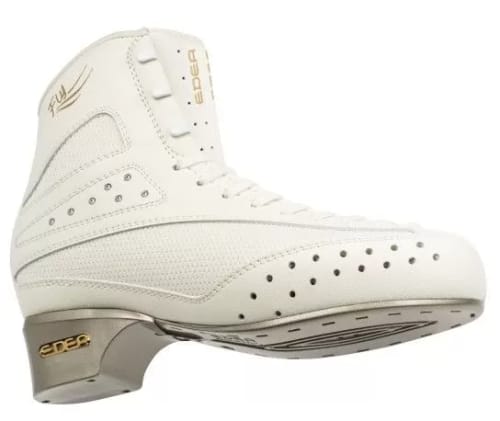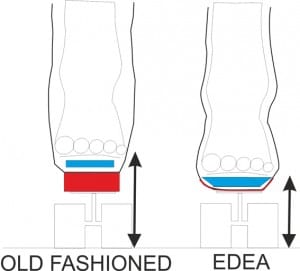We present our review of the Edea Fly figure skating boot, a very popular model among medium-high level skaters.

Characteristics
The Fly model is the top of the range model for the free specialty of figure skating, proposed by the well-known Italian company Edea. It is a boot with a support index indicated by the manufacturer as "strong", suitable for performing triple jumps. As there is no internationally standardized classification system for the stiffness of footwear, all that remains - if you want to make comparisons at the application level - is to refer to the indications provided by the various manufacturers. In this sense, the Fly boot can be considered an equal class of the Risport Mercurio Elite model, just to stay on a brand known and used in Italy. The comparison could also be extended to other products, which however are, in general, dedicated to the ice skating market and are not very widespread in Italy, so we think it is not very useful.The Fly ankle boot is made entirely of synthetic materials: no natural leather, therefore. This is definitely an advantage, both from an animalistic and a technical point of view, as the materials used have constant characteristics, from batch to batch, and uniform, so that the boots produced are almost all identical and free from defects. Furthermore, the possibility that the upper can undergo degradation phenomena due to humidity or other environmental factors is reduced and the duration of the product is increased, which, even after fairly intense use, is still able to provide performance. required by athletes, i.e. stability and stiffness.
The use of synthetic materials, such as microfiber, nylon mesh and thermoplastic material panels, also involves some disadvantages: the poor (almost nothing, we can say) breathability of the upper and the ease with which the upper itself can be damaged following the accidental contact with the track, causing the formation of unsightly abrasions. As for the first point, it must be said that even the ankle boots with leather uppers used by skaters do not possess great qualities of breathability, as, nowadays, the natural material is almost always supported by a layer of synthetic material, to obtain the desired stiffness index. Edea has tried to remedy the problem by creating a perforated insole and sole, a device that allows discreet ventilation of the foot. As regards, however, the problem of abrasions, it is good practice to always use shoe covers during training and apply some duct tape on the toe and heel of the shoe, as additional protection. The tape can eventually be removed before a competition, allowing the athlete to expose the boot perfectly intact.
One of the main advantages of the Fly boot is the system used to make the insole and sole. The first is decidedly thick and rigid, made of nylon reinforced with glass fiber, while the second is extremely thin, and is an element with a substantially aesthetic function, and not a structural one. This technical solution allows the foot to be brought closer to the skate, improving the sensitivity towards the skate.

The heel of the Fly ankle boot is made of nylon and is hollow, a solution that helps to contain the weight of the shoe. Furthermore, the ankle boot has perfectly coplanar front and heel support (at least at the design level), which facilitates the assembly of roller skating frames and makes it clear that this product has been designed specifically for this sector, and not derived directly from ice skating boots. This is an important fact, as - as is well known - ice skating boots must have different characteristics, since the way to set a curve is completely different. Having a product of this level specifically designed for roller skating is a great advantage for athletes who are dedicated to this discipline.
The Fly is available in two colors: black and white. The white model is produced in sizes from 225 to 290, the black one in sizes from 225 to 310, in steps of 5 mm. This model is offered only in the version with width C (medium) and this is definitely a disadvantage for athletes with feet with the "wide" sole, or - to put it better - with the circumference of the widest part of the sole of the foot above average. In these cases, we can intervene, widening the shoe, to adapt it to individual needs (see below).
Choice and definition of size
The Fly boot is a product intended for professional use, for athletes already in possession of a good technical background, willing to face higher difficulties, such as double and triple jumps. We strongly advise against the use of this boot for beginner athletes or in the preparation phase of single jumps: a shoe that is too stiff can, in fact, slow down learning and make the adaptation period unnecessarily long. The choice of the correct size of the boot should preferably be made under the supervision of an expert technician: come to us and we will be happy to advise you, to find the solution tailored for you. If, for any reason, you need to proceed independently, we offer you our fantastic online calculator, available at this link!
Assembly
The Fly boot can be mounted both with self-tapping screws (supplied) and with passing screws. For athletes weighing less than 40-45 kg, the first solution is perfectly functional and allows for quick assembly with minimal drilling. However, for athletes weighing more than the indicated limit, experience teaches that an assembly with through screws, or an assembly with mixed technique, is preferable, to avoid possible breakage of the plastic parts, detachment of the upper in the heel area, etc. . In choosing the ideal solution, the technical level of the athlete must of course also be taken into consideration.As for the shoe-sole contact, we always perform a check and, in case of inconsistency (due for example to small deviations from the coplanarity deriving from the craftsmanship of the manufacturing process), we provide a perfect support through the use of suitable epoxy fillers. This operation has both the purpose of avoiding deformation of the boot during assembly, and to improve the stiffness of the shoe-boot assembly, with a consequent improvement in sensitivity.
Edea does not mark the center line of its boots, so the correct alignment of the skate with respect to the sole is entrusted to the technical staff working in the stores. RooL ART has thoroughly studied this problem, which is critical for the efficiency of the finished tool, and is difficult to manage as neither the stitching on the upper nor the sole itself can be used as a reference. Rather, the overall shape of the shoe must be assessed, and the central line identified through the use of special templates, which we have developed over the years. In this way, we can guarantee the best possible centering of the boot-skate assembly and a high reproducibility of the assembly, very important characteristics for a high-level athlete in case of replacement of the boots, even during the competitive season.
Customization
The Fly boot, like most Edea products, is thermoformable. This feature is linked to the use of thermoplastic materials for the realization of the internal reinforcements of the upper. This means that, by heating the shoe to an optimal temperature, it can be permanently deformed, adapting it to the athlete's needs. RooL ART has accumulated a strong experience in performing this type of operation (we suspect we are the only ones to perform it on skating boots), so we are able to customize your Fly boots making them more comfortable and reducing the adaptation period, saving you in most cases the formation of blisters.We are also able to thermoform the EVA insole, both to increase the space available to the foot, and to obtain a "locking" effect of the foot itself inside your Fly in a sagittal direction (ie in the longitudinal direction of the foot. ): in this case, the thermoforming takes place by making the athlete wear the boot brought to the correct temperature in a convection oven, fastening it correctly and waiting for it to cool (do not try at home !!!).
Lacing
Fly boots, like all figure skating boots, should be laced correctly, using the so-called "hourglass" technique. The following video, which explains in detail how to proceed, was created by Edea:
There are two reasons why it is so important to perform a correct lacing: on the one hand it improves the comfort and effectiveness of the skating, on the other it prevents the boot from deforming and being damaged by developing folds on the upper, which would force the athlete to a substitution. Basically, a well-laced boot works better and lasts longer.
Maintenance
The most important thing about the maintenance of Fly boots is to let them dry properly after each use. At the end of each workout, we recommend that you loosen the laces up to the tip of the boot, remove the insoles and store the boots in a cool and ventilated place. Do not use hot air, do not put the boots near a heat source or expose them to the sun, to avoid damaging them! It is very important not to forget the boots in your bag, because molds and bacterial colonies could easily form inside them, a source of bad smells and serious cosmetic damage.The upper of the Fly boots can be easily cleaned, using a sponge moistened with water and, possibly with a small amount of soap, or - preferably - using a "magic sponge" type product. In any case, we recommend that you do a test in an inconspicuous area of an ankle boot before proceeding with cleaning the entire upper.
Conclusions
The Edea Fly boot is a top of the range product, for expert skaters, light and technically advanced, customizable in our laboratory, to adapt it to your foot. If assembled correctly, using our procedures, your equipment will gain value and will guarantee you a lot of satisfaction!
